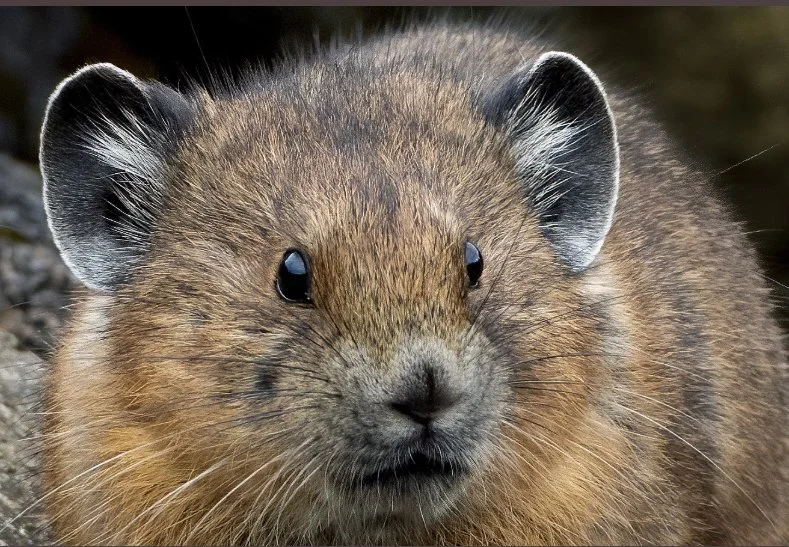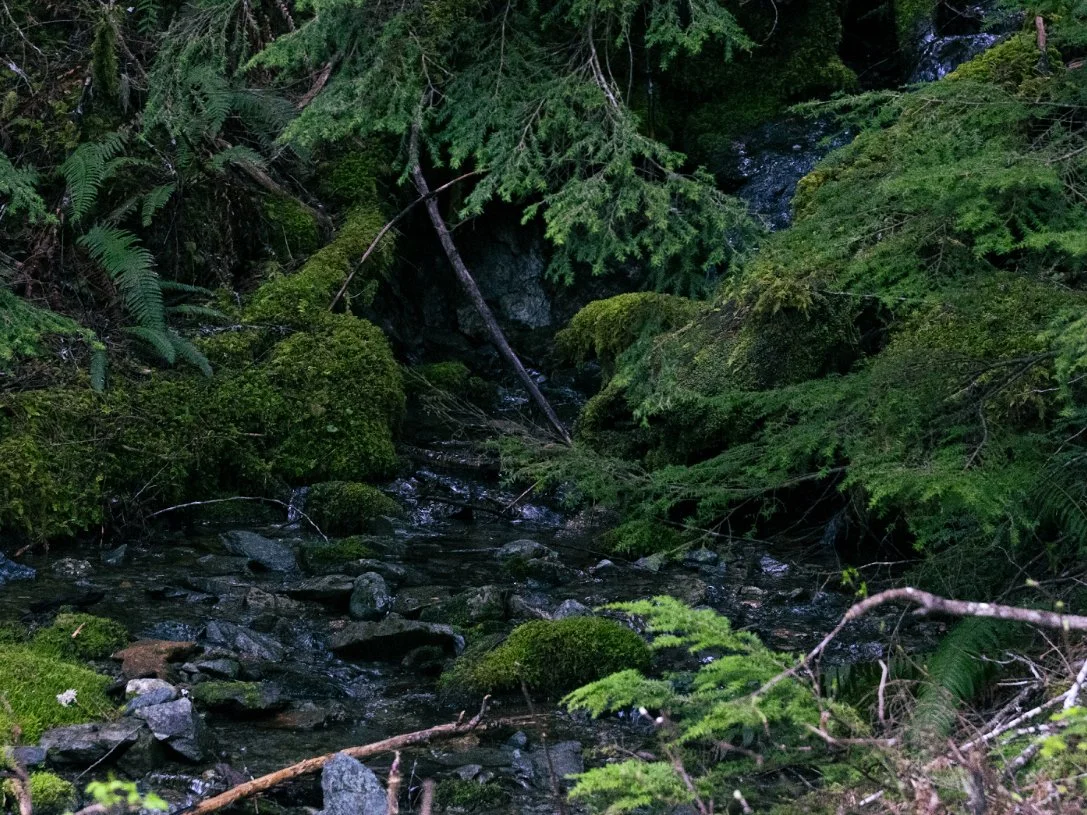Pikas Put Up A Fight
A cold creature is overheating in the Cascades
A pika up-close. // Photograph courtesy of Gregory Green
Story by Sidra Miller // Photos by and courtesy of Sophia Jellinghaus & Gregory Green
July 7, 2025
High up in the Rocky Mountains, an eerie silence has settled. The cheerful yelps of America’s cutest mammal used to ring out across mountain meadows, but their song has become harder to hear.
Travel a thousand miles west and it’s practically a symphony.
The pikas of Washington’s North Cascades are not hardier, nor smarter, than their Rocky Mountain cousins. Why, then, are Rocky Mountain pikas disappearing, while those in the Cascades seem to be doing fine?
The secret, said wildlife ecologist Gregory Green, is in the moss.
Pikas thrive in the gravel meadows of the Cascade Mountains, known as talus slopes to biologists and rocks to the rest of us. Since they can’t hibernate, pikas build themselves little forts of grass and wildflowers called haystacks, which they slowly consume throughout the winter.
Haystack construction occurs in the summertime, when the alpine is rich and green.
Johanna Varner, a professor of biology and pika expert at Colorado Mesa University, puts this seasonal cycle into perspective.
“Imagine running back and forth between the grocery store and your house 5,000 times, carrying home four heads of lettuce in your mouth,” Varner said. “That’s how much work these animals have to do.”
However, rising temperatures and precipitation changes are posing serious threats to pika foraging across both the Rockies and Cascades.
“They’re winkin’ out,” Green said.
Shuksan Peak in the spring snow. // Photo by Sophia Jellinghaus
A reduced snowpack, according to David Frey of the Wildlife Society, could be the smoking gun behind pika population decline across the species’ continental range. Snowpack is traditionally the bread and butter of pika habitat, helping to regulate their temperatures in both hot and cold seasons.
Around a quarter of Cascadian snowpack has been lost since the 1950s, according to a vulnerability assessment by the University of Washington’s Climate Impacts Group.
A warmer climate can cause pikas to freeze to death. Thick snow keeps haystacks at a cozy 32 degrees Fahrenheit. Without their snowy blanket, the creatures are exposed to colder, harsher conditions.
In the summer, reduced moisture in the environment can kill nutritious grasses and flowers, and reduce foraging time as pikas struggle to stay cool. They are a notoriously heat-sensitive species.
“If you were hanging out in Phoenix in the summer, you could only handle walking around for so long before you got really really hot and needed to go cool off,” Varner said. “If you were also having to make those 5,000 trips to the grocery store during the summer, the time you need to cool off is taking time away from that important foraging. So then, during the winter, you might not have enough food to survive.”
A mere handful of hours above 77 degrees Fahrenheit can prove fatal to pikas.
The threats facing pikas are certainly severe. The possibility of death by starvation, cold and heat looms ever larger as the climate crisis progresses.
There’s an unusual hero waiting in the wings.
Moss.
The relentless damp of the low-elevation Cascade mountains provides a habitat unique from any other in the pika range. That unassuming fluff enveloping the rocks, trees and occasionally people is helping save the lives of local pikas.
In the Pacific Northwest, moss acts as a habitat proxy for snow and provides a year-round food source. The abundant plant can replace traditional haystacks, helping pikas avoid that pesky winter-home-building stress.
Moss also allows foraging pikas to remain in a comfortable temperature range. The pikas can consume what’s directly around them, rather than venturing far into alpine meadows in search of dinner. It’s quite a unique preference. Most mammals eschew moss in favor of more energy-dense food.
“It’s basically the nutritional equivalent of a cardboard box,” Varner said.
Cascadian pikas, however, appear to be quite the cardboard fiends.
In the biology world, the Cascadian pika’s distinctive adaptation to moss is known as behavioral plasticity. This plasticity means they’ve been able to change their behavior to accommodate shifts in the food supply and snowpack.
Exploring plasticity is an exciting new field for pika-ologists. The creatures may prove to be far more resilient than traditionally given credit.
A mossy brook on Mount Baker. //Photo by Sophia Jellinghaus
“They’re plucky and they’re survivors,” Varner said. She spoke of a particularly plucky pika from a recent study. “There was one we nicknamed Mr. Cheekypants. He was really cheeky.”
Despite this purported adaptability and cheery attitude, Cascadian pikas are not quite in the clear. In fact, they love playing hard to get.
Both Varner and Green remarked that very few people, if any, are keeping track of pika populations in northwest Washington. Pikas are small, quick and live in hard-to-access places. If that wasn’t enough, the slashed budgets of the Trump Administration are proving a near insurmountable hurdle. Funding for monitoring projects is practically impossible to come by.
The Washington Department of Fish and Wildlife, Environmental Protection Agency, Washington Department of Natural Resources and Washington State Climate Office all expressed that they were unable, whether from lack of funding or interest, to study pikas in the Cascades.
Kirsten McDade of RE Sources, a prominent Bellingham climate nonprofit, spoke to the importance of an alternative solution: citizen science. Citizen scientists can help to fill in the gaps where professionals are missing, according to McDade.
“They’re on the water, on the ground, so much more pervasively than the scientists are,” McDade said.
While pika monitoring is not quite in RE Source’s wheelhouse, the citizen observation niche is alive with potential. The people of Bellingham are, from what she’s seen, especially excited to be involved. Perhaps all that is needed is a push in the right direction — up to the mountains.
Pikas, as an indicator species, act as canaries in the proverbial coal mine of climate change. Indicator species are typically a sensitive species whose health reflects conditions of a given ecosystem, and are useful in gauging the severity of local changes in climate.
Climate scientist Andy Bunn explained that pikas are vulnerable to what’s known as the escalator effect. This is a scientific term coined to describe the plight of alpine mammals in times of climate crisis. As animals move up the mountain to stay cool, they run out of habitat.
“The simple idea is that mountains are cones, right, so as you go up there’s less and less area,” Bunn said.
However, the reality of mountain habitat is not so clear cut.
“Mountains are complicated. They’re really wrinkly.” Bunn said.
Pockets of cold habitat can remain at lower elevations despite overall warming trends. Such pockets are known as refugia, or refuges and they can help keep the little fellas safe.
It’s not much – nooks, crannies, and moss – and yet the Cascadian pikas soldier on.
And come late summer, they’ll emerge from their mossy shelters to start again, building their haystacks, harvesting wildflowers and dreaming of snow.



